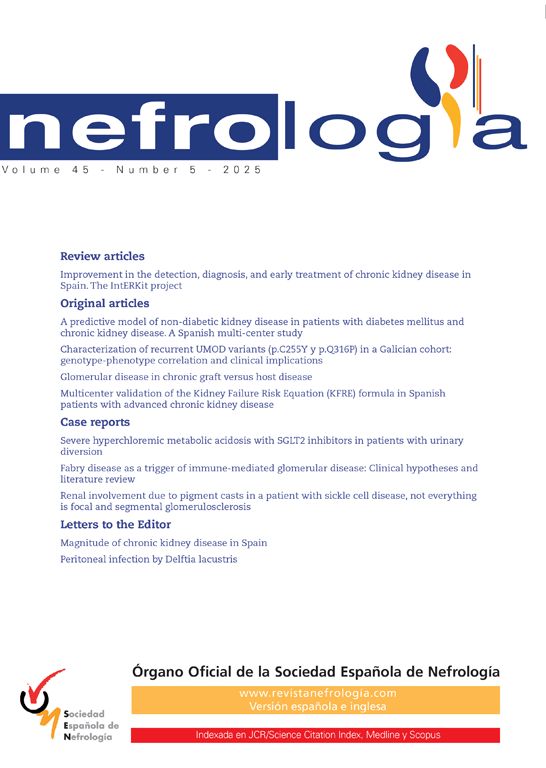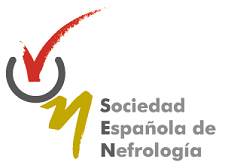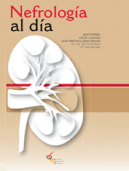Acute kidney injury (AKI) is defined as a sudden decrease in the kidney's ability to eliminate nitrogenous products and it is often accompanied by a decrease in urine output.1 The RIFLE and AKIN classifications, and more recently, the KDIGO classification,1 have defined the criteria for diagnostic and severity of AKI. However, none of them provide useful information for the early detection and monitoring of acute kidney injury.2
An increase in serum creatinine and urea levels determine the diagnosis of AKI; however, these measurements have significant limitations for the diagnosis of AKI. Serum creatinine levels increase late in acute kidney injury, while serum urea levels are influenced by other non-renal factors.3 Other markers of kidney damage have been described, such as proteins and peptides (cystatin C, interleukin 18, kidney injury molecule 1, neutrophil gelatinase-associated lipocalin, among others).4 Most of these biomarkers correlate with tubular injury but also with other inflammatory diseases such as sepsis or chronic kidney disease (CKD4; this is the reason why they lose usefulness for the specific diagnosis, early detection and prediction of the prognosis of acute kidney injury.
In this context, there has been proposed the use of new tools for the diagnosis, prognosis, and monitoring of AKI, such as proteomics and metabolomics. Proteins constitute the main functional and structural units of cells, and their effects on cellular function are defined by the set of metabolites synthesized or degraded by the specific enzymatic action of certain proteins. The specific pattern of protein (proteome) and metabolite (metabolome) expression defines the biological state of the organ or tissue.5
The study of the proteome (proteomics) and metabolome (metabolomics) has been proposed as a useful tool for the discovery of diagnostic and prognostic biomarkers for AKI. Unlike proteomics, metabolomics provides comprehensive information on the metabolic processes of the cell by identifying the products resulting from metabolic reactions. The description of the proteome (using, for example, mass spectrometry) and the metabolome (using, as an example, magnetic resonance spectroscopy) allows the description of molecular patterns that are useful as diagnostic, prognostic or therapeutic response biomarkers.5
In metabolomics, there are two main approaches: untargeted (unsupervised) analyses and targeted (supervised) analyses. Targeted analyses focus on a specific set of compounds, which are often similar in structure and chemical properties or derive from the same biological pathway. In contrast, untargeted approaches take a holistic approach, attempting to measure as many metabolites as possible in an unsupervised manner and using statistical tools to identify those that differ between healthy and diseased individuals.4,6 Untargeted approaches are more difficult, and their results can lead to new hypotheses for disease diagnosis (Fig. 1).
In CKD, several studies have identified metabolites associated with disease progression. Significant changes in the clearance of endogenous uremic solutes (such as p-cresol, indoxyl sulfate, and phenylacetylglutamine)7 have been described, which could be considered as signals for early detection of CKD. The study of the usefulness of metabolomics in AKI is still in its early stages, and many aspects remain to be clarified. Compounds related to xenobiotic metabolism (such as cytochrome P450, arginine, and proline) have been identified in ARF patients.8 Furthermore, in critically ill patients, the concentration of tissue inhibitor of metalloproteinase (TIMP)-2 and insulin-like growth factor-binding protein (IGFBP)-7 have been reported to correlate with the severity and duration of AKI.5,9
In summary, the traditional approach based on determining the concentration of certain molecules as ARF biomarkers has significant limitations. Future approaches using unsupervised techniques that describe metabolomic patterns that reflect the metabolic status of the cell hold promise for the discovery of biomarkers that may be useful for the early diagnosis, prognosis, and monitoring of AKI.







